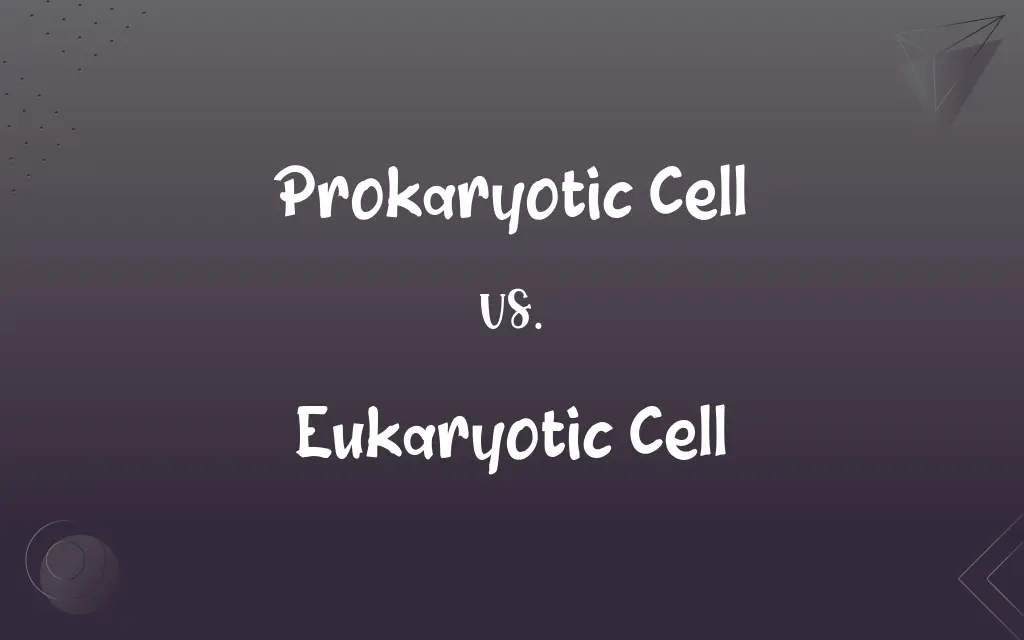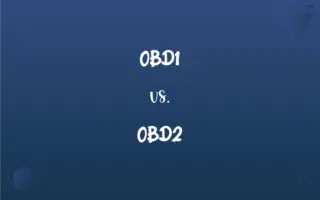Prokaryotic Cell vs. Eukaryotic Cell: What's the Difference?
Edited by Janet White || By Harlon Moss || Updated on July 11, 2024
Prokaryotic cells lack a nucleus and membrane-bound organelles, while eukaryotic cells possess a nucleus and have membrane-bound organelles.

Key Differences
A pivotal difference between prokaryotic cell and eukaryotic cell resides in the presence of a nucleus. Prokaryotic cells lack a true, membrane-bound nucleus, with their genetic material instead found floating in the cytoplasm. Conversely, eukaryotic cells proudly exhibit a well-defined, membrane-bound nucleus that houses the cell’s genetic material, securely separating it from the cytoplasm and providing an additional layer of protection and organization.
Diving into cellular complexity, the prokaryotic cell traditionally exhibits a simpler structure with no membrane-bound organelles. The absence of such compartments, like the mitochondria or endoplasmic reticulum, distinguishes it from the eukaryotic cell. Eukaryotic cells, embracing complexity, not only feature a plethora of membrane-bound organelles but also ensure a variety of specialized tasks are undertaken within these biological units, enhancing the efficiency and functionality of the cell.
Examining the size and structural complexity, a prokaryotic cell tends to be smaller and structurally straightforward, typically adhering to a size range of 0.5–5 micrometers. Conversely, the eukaryotic cell extends notably larger, usually between 10–100 micrometers, often attributed to its additional structural components and the necessity to house numerous organelles, suggesting a fascinating divergence in the cellular architecture when comparing the prokaryotic cell and eukaryotic cell.
From a reproductive perspective, prokaryotic cells usually divide by binary fission, a relatively straightforward process involving the duplication and separation of genetic material and cellular contents. The eukaryotic cell, showcasing a more intricate reproductive mechanism, undergoes mitosis, where the genetic material is meticulously separated, and cytokinesis, asserting a distinct difference in the reproductive methodologies between the prokaryotic cell and eukaryotic cell.
Upon investigating genetic material, the prokaryotic cell generally contains singular, circular DNA, absent of histones. In striking contrast, the eukaryotic cell not only harbors multiple, linear DNA molecules but also associates them with histones, forming chromatin. This critical distinction reveals not only variations in DNA structure and organization between prokaryotic cell and eukaryotic cell but also alludes to the complexity of genetic regulation and expression exhibited by the latter.
ADVERTISEMENT
Comparison Chart
Nucleus
Absent, DNA is found in the cytoplasm
Present, contains the cell’s genetic material
Membrane-bound Organelles
Absent, lacks structures like the mitochondria
Present, including the mitochondria, endoplasmic reticulum, etc.
Size
Generally smaller, ranging from 0.5–5 micrometers
Larger, usually between 10–100 micrometers
Reproductive Method
Typically divides by binary fission
Utilizes mitosis and cytokinesis for cell division
DNA Structure
Contains singular, circular DNA without histones
Houses multiple, linear DNA molecules associated with histones
ADVERTISEMENT
Prokaryotic Cell and Eukaryotic Cell Definitions
Prokaryotic Cell
Prokaryotic cells are fundamental, unicellular organisms without a defined nucleus.
Bacteria, a type of prokaryotic cell, are present in various environments from hot springs to human guts.
Eukaryotic Cell
These cells undergo a sophisticated division process, involving mitosis and cytokinesis.
The eukaryotic cell ensures accurate DNA distribution to its daughter cells through mitotic processes.
Prokaryotic Cell
These cells typically contain a singular, circular DNA molecule within the cytoplasm.
The genetic information of the prokaryotic cell is easily accessible due to its singular DNA presence in the cytoplasm.
Eukaryotic Cell
Eukaryotic cells contain linear DNA associated with histones, forming a complex chromatin structure.
In a eukaryotic cell, the chromatin within the nucleus condenses to form chromosomes during cell division.
Prokaryotic Cell
Reproduction in prokaryotic cells predominantly occurs through a process known as binary fission.
During binary fission, a prokaryotic cell divides into two identical daughter cells, facilitating rapid reproduction.
Eukaryotic Cell
Eukaryotic cells can be unicellular or multicellular and are found in organisms like animals, plants, and fungi.
Yeasts are unicellular organisms that consist of eukaryotic cells, exhibiting a simple structure yet having organelles.
Prokaryotic Cell
Prokaryotic cells can have a variety of shapes, such as cocci, bacilli, or spirilla.
The spirilla category of prokaryotic cell exhibits a spiral shape and can be found in various environments.
Eukaryotic Cell
These cells showcase a variety of membrane-bound organelles, like mitochondria and the endoplasmic reticulum.
The eukaryotic cell utilizes its mitochondria to produce energy through cellular respiration.
Prokaryotic Cell
Prokaryotic cells lack membrane-bound organelles and therefore have a simpler internal structure.
Mitochondria are absent in the prokaryotic cell, which impacts their energy production processes.
Eukaryotic Cell
Eukaryotic cells are characterized by the presence of a well-defined, membrane-bound nucleus.
Human cells are a type of eukaryotic cell, containing a nucleus that houses DNA.
FAQs
What is the fundamental difference between a prokaryotic cell and a eukaryotic cell?
Prokaryotic cells lack a nucleus and membrane-bound organelles, whereas eukaryotic cells contain a nucleus and have membrane-bound organelles.
Are viruses prokaryotic or eukaryotic?
Viruses are neither prokaryotic nor eukaryotic; they lack cellular structure and require host cells to reproduce.
Can prokaryotic cells form multicellular organisms?
Generally, no. Prokaryotic cells are typically unicellular, whereas eukaryotic cells can be either.
What enables eukaryotic cells to form complex multicellular organisms?
Eukaryotic cells have the ability to communicate and cooperate with each other, enabling them to form structured tissues and organisms, supported by their compartmentalized internal structures that allow for specialized functionality.
How does antibiotic resistance occur in prokaryotic cells?
Antibiotic resistance in prokaryotic cells can arise through mutations or the acquisition of resistant genes from other cells, enabling them to survive and reproduce in the presence of antibiotics, often involving mechanisms like drug efflux or modification.
Which organisms contain prokaryotic cells?
Bacteria and Archaea are examples of organisms containing prokaryotic cells.
Which is more complex, a prokaryotic cell or a eukaryotic cell?
Eukaryotic cells are more complex due to their nucleus and variety of organelles.
What is the significance of the membrane-bound nucleus in eukaryotic cells?
The membrane-bound nucleus in eukaryotic cells isolates and protects genetic material, enabling controlled and regulated gene expression and DNA replication.
How do prokaryotic cells protect their genetic material without a nucleus?
Prokaryotic cells often protect their DNA by supercoiling or associating it with proteins, creating a nucleoid region, even though it is not isolated within a defined nucleus.
Is there a size difference between prokaryotic and eukaryotic cells?
Generally, eukaryotic cells are larger than prokaryotic cells, owing to their complex internal structure and the presence of numerous organelles.
How do prokaryotic cells produce energy without mitochondria?
Prokaryotic cells generate energy through processes like glycolysis and fermentation in the cytoplasm.
Why do eukaryotic cells have varied shapes and sizes?
The presence of a cytoskeleton and multiple organelles in eukaryotic cells allows for a diversity in shapes and sizes to suit the specific functions and needs of different cell types.
Can both prokaryotic and eukaryotic cells form biofilms?
Yes, both prokaryotic (especially bacteria) and eukaryotic cells (like fungi) can form biofilms, which are structured communities of cells that can adhere to surfaces and interfaces.
Can eukaryotic cells survive without a nucleus?
Eukaryotic cells can sometimes survive temporarily without a nucleus, especially if their immediate environment is stable, but they are unable to divide or regulate gene expression effectively in the absence of a nucleus.
Are human cells prokaryotic or eukaryotic?
Human cells are eukaryotic.
How do prokaryotic cells handle genetic material without a defined nucleus?
Prokaryotic cells contain a single, often circular, DNA molecule in the cytoplasm, which is freely accessible and not enclosed within a membrane-bound nucleus, enabling straightforward access for transcription and replication.
What role does the nucleus play in eukaryotic cells?
The nucleus houses genetic material (DNA) and controls cellular activities by regulating gene expression.
What is binary fission in the context of prokaryotic cells?
Binary fission is a method of asexual reproduction in prokaryotic cells, where one cell divides into two identical cells.
Which type of cell, prokaryotic or eukaryotic, is older evolutionarily?
Prokaryotic cells are evolutionarily older than eukaryotic cells.
How does the absence of organelles impact the functioning of prokaryotic cells?
The absence of organelles in prokaryotic cells simplifies their internal structure and metabolic pathways, often leading to a reliance on the cell membrane for energy production and other essential processes.
About Author
Written by
Harlon MossHarlon is a seasoned quality moderator and accomplished content writer for Difference Wiki. An alumnus of the prestigious University of California, he earned his degree in Computer Science. Leveraging his academic background, Harlon brings a meticulous and informed perspective to his work, ensuring content accuracy and excellence.
Edited by
Janet WhiteJanet White has been an esteemed writer and blogger for Difference Wiki. Holding a Master's degree in Science and Medical Journalism from the prestigious Boston University, she has consistently demonstrated her expertise and passion for her field. When she's not immersed in her work, Janet relishes her time exercising, delving into a good book, and cherishing moments with friends and family.































































